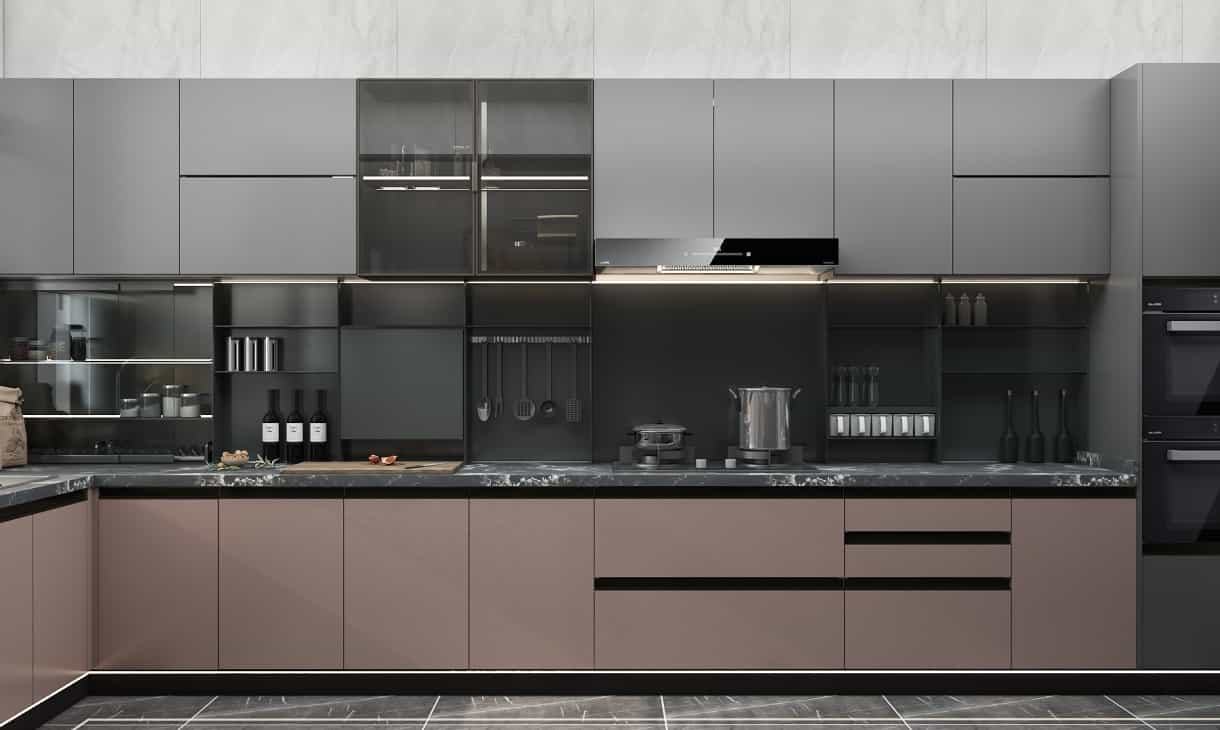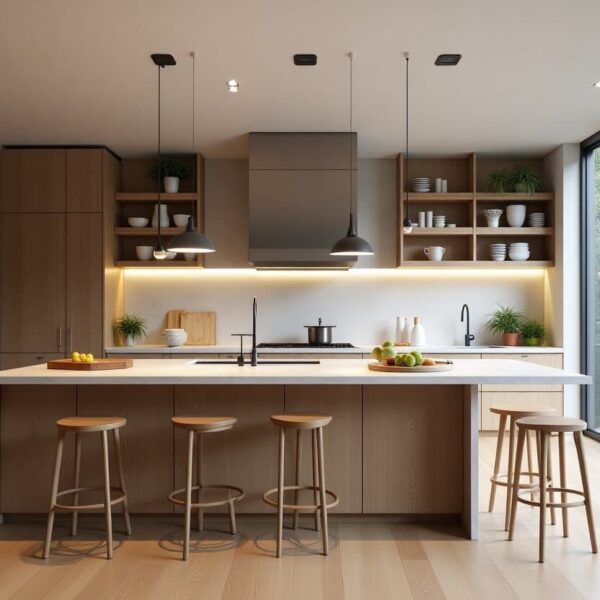In the fast-evolving custom cabinetry industry, design is almost everything. A unique layout, an ingenious hardware solution for a tight space – these could be the “secret sauce” that makes your product stand out. But what happens if that “secret sauce” gets copied?
When you choose to partner with a Chinese kitchen cabinet manufacturer, a smart move for both quality and competitive pricing, you might naturally worry about your brilliant designs being replicated. It’s a valid concern, as IP leakage, from detailed drawings and structural blueprints to clever functional mechanisms, is a common pitfall.
Here’s the crucial takeaway, though: with the right preparation, your intellectual property (IP) can be effectively protected in China. This blog post is your definitive guide, arming you with the knowledge to safeguard your designs and creative ideas throughout the entire Chinese procurement process.

What Qualifies as “IP” in a Custom Cabinet Project
In the world of custom kitchen cabinets, intellectual property goes far beyond just logos or product names. If you’re investing time and creativity into your design — whether it’s a minimalist Scandinavian layout, an inventive corner storage solution, or a unique pull-out system — it likely qualifies as intellectual property (IP).
Design files such as 2D drawings, 3D renderings, and elevation views are key assets. They reflect not only the visual appearance of your cabinet but also its structural logic and intended function. These files are the blueprint of your product and often hold competitive value.
In addition, material choices, finish specifications, and internal configuration ideas (like how drawers are divided or which hardware mechanisms are used) are considered protectable design content. Even elements that aren’t visible at first glance — such as the placement of a hidden trash bin or soft-close hinges — can be integral parts of your IP portfolio.
Don’t overlook branding either. Your logo, your cabinet collection name, or even the unique look of your packaging design may also fall under IP protection. In short, anything that reflects your original thought, solves a functional challenge, or brings aesthetic distinction can and should be protected in the manufacturing process.

Why China Registration Is Non-Negotiable
One of the most common and costly mistakes many foreign cabinet buyers make is assuming that registering their trademark or design in their home country automatically protects them in China too. Unfortunately, this understanding simply doesn’t apply in China. China operates on a strict “first-to-file” principle, meaning whoever registers the intellectual property first owns the rights, regardless of who the original creator was. If you delay registration, your design drawings or brand name could be registered by someone else—perhaps even a Chinese kitchen cabinet supplier you’ve already approached. Once this happens, protecting your rights later becomes incredibly complex and expensive.
Therefore, we highly recommend you consider completing your intellectual property registration locally in China. This registration should cover not only your trademarks and logos but also secure design patents or copyrights for your drawings and renderings. We suggest working through a reputable local Chinese IP agency or law firm to ensure the registration is legitimate, effective, and legally enforceable. In short, registering early is the golden rule for IP protection in China.

Build Your Legal Shield Before Sharing Any Design
Once you’ve clearly defined your IP and committed to registering it in China, your next crucial step is to legally protect your designs before they ever leave your computer.
Rather than relying on a traditional Non-Disclosure Agreement (NDA), the more effective approach for the Chinese market is to sign an NNN Agreement (Non-Disclosure, Non-Use, Non-Circumvention). This type of agreement is specifically designed for the Chinese legal system, offering far greater enforceability than a standard NDA. It explicitly prohibits the manufacturer from disclosing, copying, or circumventing your designs without authorization, and it clearly defines substantial liquidated damages to serve as a significant deterrent.
Crucially, the confidentiality obligations in an NNN should continue for 3-5 years after the contract terminates. To ensure legal validity, we recommend using a bilingual (Chinese and English) text and stipulating that the agreement is governed by Chinese law. Simultaneously, in your OEM contract, you should clearly state that the design belongs to the client, that the manufacturer cannot reuse the design for other clients (especially competitors), and include exclusive manufacturing rights with both geographic and time limitations. This prevents them from simply waiting out your contract and then selling your design to others.
By finalizing these legal arrangements before delivering any drawings, you not only significantly reduce the risk of infringement but also send a clear signal to your Chinese kitchen cabinet manufacturer that you take intellectual property very seriously. This will, in turn, earn you greater respect and prioritize cooperation from truly professional suppliers.
Practical Anti-Copy Measures You Should Know

While signing legal agreements is essential, everyday protective measures are equally critical in a cross-border collaboration. Many businesses, especially in international partnerships, prematurely share complete, editable drawings early in a project, inadvertently providing unscrupulous manufacturers with a full “blueprint for replication.” To avoid this, there are smarter approaches.
One effective strategy is to embed invisible watermarks into your CAD drawings or renderings and include metadata. These subtle markings not only serve as a deterrent but can also help trace the source if a leak occurs. Furthermore, in the initial communication phases, consider providing only low-resolution preview images or displaying only partial views, rather than the full set of drawings.
We advise against submitting complete, editable files until it is absolutely necessary and all legal agreements are firmly in place. If you must provide drawings, prioritize using non-editable formats like PDF over full CAD source files to increase the difficulty of malicious imitation. For physical samples, anti-counterfeiting technologies like RFID tags or unique QR codes can help verify product authenticity and origin within the supply chain.
Have a project in mind? Send a message.
Get the catalog for free
Another highly effective and secure strategy is to adopt a “staged drawing submission” approach. For instance, during the initial quotation and sampling phases, only provide exterior product views, concealing critical details such as internal structures or complex process parameters. Only after the contract is formally signed and the collaborative relationship established should you supplement with internal structural or process details. These simple yet powerful practices help safeguard your intellectual property while maintaining smooth and efficient cooperation.
Additionally, adopt a multi-tiered supply chain management strategy. Avoid letting a single supplier control every single aspect of your production. Instead, diversify by having different elements handled by different factories—for instance, material procurement, design production, and surface treatment could be outsourced to separate entities. Alongside this, implement strict quality control checkpoints, perhaps by hiring a third party for random inspections at various stages. Finally, a powerful measure is to leverage China Customs IP Recordal. By recording your registered IP with China Customs, you can effectively block the export of infringing products. China’s General Administration of Customs has an IP recordal system that can detain suspicious goods right at the border.

What If Someone Steals Your Design?
Even with strong contracts and preventive strategies in place, design infringement can still happen. The reality is that in the digital manufacturing world, files can be copied in seconds and knockoff versions may appear online or in overseas markets before you even realize it. That’s why ongoing vigilance is just as important as upfront protection.
The first step is to monitor the market actively. Keep an eye on major e-commerce platforms like Alibaba, Amazon, and Etsy, as well as industry trade shows where similar designs might surface. Reverse image search tools such as Google Lens can help you spot unauthorized copies of your cabinets and identify suspicious sellers.
If you discover a copy of your design, act swiftly. A cease-and-desist letter issued by a qualified Chinese intellectual property lawyer can often be enough to prompt infringers to remove listings or halt production. It’s important to address the issue early, before it spreads or becomes more difficult to control.
For more serious or repeated infringements, you may need to escalate the matter. Having your intellectual property registered with Chinese customs allows officials to block counterfeit shipments at the border. In your contracts, you can also stipulate that disputes be handled through international arbitration, such as via the Singapore International Arbitration Centre, and specify a governing law with strong IP protections, such as U.S. or EU law.
Ultimately, having a response plan in place gives you leverage. Being ready to act — and acting confidently — sends a clear signal to suppliers and competitors that your designs are not up for grabs.

Special Considerations for International Sales
IP laws vary significantly across borders. What works in one country might not in another.
Understanding Global IP Differences:
- Europe: Supports unregistered design rights in some cases.
- United States: Emphasizes design patents for aesthetic protection.
- China: Strongly emphasizes “first-to-file” registration.
Localized Legal Support: For key markets beyond China (e.g., Southeast Asia), it’s wise to hire professional IP lawyers who understand the local nuances to assist with enforcement.
Plan Early, Sleep Easy
Creativity is your most valuable asset. While IP theft is a risk, it’s a manageable one — as long as you’re proactive and partner with the right Chinese kitchen cabinet supplier.
Nexthome Furnishing is a leading Chinese integrated home furniture brand, specializing in China custom kitchen cabinet, wardrobes, other storage cabinetry, and loose furniture. With over 10 years of experience in high-end customization, we deeply understand the intricacies of bespoke furniture and the value of your unique designs.
At Nexthome Furnishing, we don’t just build furniture; we build trust. We prioritize and respect our clients’ intellectual property. Our processes include robust contractual agreements and secure handling of your proprietary designs. We are committed to fostering long-term partnerships based on transparency and a shared dedication to quality and IP integrity.
Ready to build your next cabinet project — safely? Get in touch with Nexthome today.
Contact NextHome Now!
We are here to help you with your business needs. We have a team of experts who are always eager to help you.



